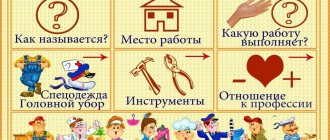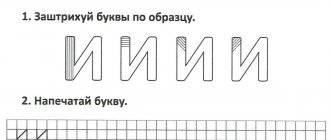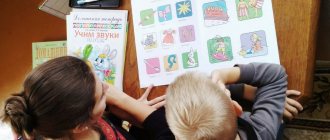Frontal speech therapy session with presentation for the senior group, taking into account the Federal State Educational Standard for Preschool Education
Frontal speech therapy lesson for children of the senior group “Jam from the clouds”
The article was compiled based on materials from Elena Matvienko, Lydia Slutskaya, E. Koshkarova, T. Kersten.
This material is intended for speech therapists and kindergarten teachers.
The lesson notes were compiled taking into account the federal educational standard for preschool education. Frontal speech therapy lesson for children of the senior group “Jam from the clouds” Goal: the formation of positive attitudes towards various types of work and creativity. Program content Educational objectives: - teach children to establish contact with each other, promote group cohesion; - help reduce emotional stress and impulsiveness. Developmental: - develop attention, speech, imagination, memory, thinking. Educational: - cultivate a friendly attitude towards each other. Preliminary work: Vocabulary work: self-massage, landscape. Materials and equipment: multimedia presentation, gas scarves of different colors, handouts for non-traditional finger painting “Baby Elephant”, stereo system, fermented milk product.
Progress of activities:
I. Organizational moment. 1. Game - greeting with musical accompaniment. 1: Come in, come in, all the kids! It's good that you came. - Well, hello, guys! - Hello! - How are you feeling? - Very good! - It's time for us to get busy. - Yes Yes Yes! - We will all try - Just like always. - We will draw and answer questions. I ask you guys to repeat after me. 2: Come in, the puppies have come to visit us. Answer as they do. - Well, hello, puppies! - Woof woof woof! - How are you feeling? - Woof-woof-woof-woof-woof! - It's time for us to get busy. - Woof woof woof! - We will all try - Woof-woof-woof-woof-woof! - We will dance and sing songs. I ask you, puppies, to repeat after me. 3: Come in, come in, all the kids! It's good that you came. - Well, hello, guys! - Hello! - How are you feeling? - Very good! - It's time for us to get busy. - Yes Yes Yes! - We will all try - Just like always. - We will draw and answer questions. I ask you guys to sit down at the table now. II. State the topic and purpose of the lesson. - Today you and I will play with the clouds. And you will find out how we will do this a little later. III. Main part. 1. Conversation about what color clouds are. — Guys, what color are clouds? - White! - Is it only white? No. Clouds come in other colors, and you will find out which ones by watching the presentation. Attention to the board. 2. Multimedia presentation with musical accompaniment “Sunset Jam” Have you ever tried Sunset Jam? Here it is strawberry, Well, and then blueberry. A bit unusual, but tastes great. Such a wonderful dinner is always ready for us. Don't forget to blow off the foam from the fresh clouds. 3. Discussion of what was seen. — What color are clouds? - Red, orange, blue, purple, gray, single, crimson. - Why is this happening? — The sun rises and sets, painting the clouds in different colors. 4. Self-massage with handkerchiefs. The guys receive gauze handkerchiefs of different colors and do self-massage under the guidance of an educational psychologist. — The clouds are falling onto our palm. — First we stroke the right palm, then the left palm. — We stroke the arms from the shoulder to the fingers. — We pass the handkerchief between our fingers. - Let's hide the cloud in our fist and release it. Place tissues next to the child. 5. Physical exercise “Baby Elephant on a Cloud.” There lived a gray little elephant on a white cloud. He flew quietly across the blue sky. And the little elephant trumpeted colorful songs about what he saw and loved. When he looked at the bright Sun, He sang red songs cheerfully. When he lowered his head down, he sang green songs. 6. Collective work in the non-traditional technique of finger painting (trunk) with the help of a baby elephant. – We are not releasing the baby elephant. We will ask him to stay with us and help us draw clouds in the sky. IV. Summary of the lesson. - What did you like?
-What was fun? “And now we’ll all taste the clouds together.” The guys taste the clouds (fermented milk product). Presentation for frontal speech therapy classes for the senior group, taking into account the Federal State Educational Standard for Preschool Education
We recommend watching:
Notes on speech therapy for the senior group. Notes on a game lesson in the senior group on speech development. Notes on an individual lesson on differentiating sounds etc. for children in the senior group. Correctional and developmental activities with a subgroup of children 5-6. Abstract
Similar articles:
Musical lesson using logorhythmics in the senior group of a preschool educational institution
Summary of an integrated lesson on the topic “Animals” in the senior group
Lesson summary - travel for children of the senior group of preschool educational institutions on the topic: Birds
Summary of an integrated lesson on the topic “Space”. Senior group
Development of notes for speech therapy classes according to the Federal State Educational Standard; methodological development for speech therapy on the topic
| Development of notes for speech therapy classes according to the Federal State Educational Standard |
Guidelines
Explanatory note
An analysis of the methodological work on training speech therapist students during their pre-graduate practice shows that most of them cannot cope with independently compiling lesson notes. Difficulties are expressed in the lack of understanding of the goals and objectives of each stage of work, the inability to select tasks to achieve these goals and objectives, and characteristic methodological errors. A memo and methodological recommendations for taking notes have been developed to help students and speech therapists who are starting to work according to the Federal State Educational Standard at the stage of forming phonetic-phonemic concepts in children with speech disorders.
I. General notes on note-taking
- Correspondence of the topic, purpose and content of the summary to the stage of correctional work.
- Subordination of all tasks to the main goal of the lesson.
- Logical completeness of each task (presence of mini-conclusions).
- Smooth transitions from one task to another (predicting children’s answers that can serve as key phrases for moving on to the next task; taking into account the plot and (or) thematic line, if any).
- Completeness of presentation of forms of organization, methods and techniques, types of work.
II. Methodological recommendations for constructing work at different stages of the lesson
1. Motivational-target stage
The first stage of the lesson according to the Federal State Educational Standard is called “motivational-target”. Motivation arises when children see a problem, a discrepancy. It is necessary to bring the children to a vision of this problem, and then solve it together with them. For example, let's suggest finding out how the differentiated sounds [l'] - [th'] are similar. By updating the existing knowledge about these sounds, we give them characteristics (for example: consonants, voiced, soft) and draw a conclusion why exactly these sounds “came” to the lesson (they are similar). The purpose of the lesson will follow naturally from the conclusion: since the sounds are so similar to each other, it means they can be confused, so there is a need to learn to distinguish them. The designation of mixed sounds [l'] - [th'] with letters is the next stage (“indicative”), since the letter designation of these phonemes contains a difference, we will also rely on it during differentiation.
Thus, the technology of work at the motivational-target stage may be as follows:
- We lead the children to formulate the topic. (What will we study, what will we talk about)
- Let's pose a problem. (What might be difficult? What is the danger? What can we do and what can’t we? What do we already know and what don’t?)
- We formulate a goal. (The goal follows logically from the problem posed: what we don’t know, we need to find out; what we don’t know how to do, we need to learn. If there is any danger (difficulty), we need to deal with it). Those. To set a goal, it is necessary to update children’s existing ideas.
An example of constructing work at the motivational-target stage in classes on the topic “Sounds [l] - [l']. Letter "l":
Two approaches to posing the problem.
- (Easier option) If the topic sounds like “Sounds [l] - [l']”, you can update your knowledge about sounds, namely, determine their general properties (consonants, voiced, tongue raised up, etc.). Then the problem arises - they can be confused and pronounced incorrectly. We set a goal: we will learn to pronounce sounds correctly.
- If we write down and formulate the topic as “Sounds [l] - [l']. The letter “l”, then we will update knowledge about sounds (what they are, how they are similar and how they differ) and their letter designation (one letter can represent two sounds). What problem arises from this? (You can pronounce a word incorrectly, read a word, write it). Then the goal: learn to correctly pronounce words with these sounds, read and write them.
In the Instructional and Methodological Letter to A.V. Yastrebova and T.P. Bessonova, the topic is: “Sounds [l] - [l']. Letter "l". In accordance with the sequence of work on overcoming phonetic-phonemic disorders (“phoneme – articuleme – grapheme – kineme”), it will not be a mistake if in the first lesson we teach children to pronounce and distinguish sounds. In the subsequent lesson(s), you can pay attention in the structure of the lesson to studying the writing of the letter “l” and writing it separately from other letters and in merging with them (prevention of optical dysgraphia, since there are frequent cases of adding extra elements to the letter) . In other words, the goal of the first lesson will be to correct sound pronunciation and form phonemic representations, and the main goal of the second (or subsequent lessons) will be to improve sound-letter representations, optical-spatial orientation and grapho-motor functions.
2. Indicative stage
The purpose of this stage is to teach children how to work to achieve their goal. (How to distinguish between sounds and letters; how to correctly pronounce a sound, write and read a letter)
At the indicative stage, you can propose the following task:
—What is the difference between a sound and a letter? (“I hear a sound, I pronounce it, I see a letter, I read it, I write it”).
In this way, we will regulate the children’s activities, suggest a way to solve the task: how to learn to pronounce sounds correctly and denote them with a letter, which organs will be involved in this work.
In classes on differentiating sounds, the indicative stage can be carried out in the form of repetition and consolidation of methods for distinguishing them. Then the main work at this stage will be aimed at solving the question: how to learn to distinguish sounds?
3. Search and research stage
The search and research stage involves identifying unknown information by using existing knowledge and a creative approach to realizing the goal of the lesson.
For example, in a lesson on the topic “Sounds [l], [l'] and the letter “l,” you can invite children to fantasize - what does the letter “L” look like? It is very appropriate to work on the analysis of the components of a letter (how many elements are in a capital letter? What are they? What do they look like? How and where are they connected to each other). As a productive activity at this stage, it is advisable to invite children to either write out a letter or build it from a paper construction set (circle it along the contour, assemble it from pebbles, buttons or other improvised material along pre-prepared contours - there can be many options).
An excellent material for research activities can be a set of pictures depicting the names of familiar articulation exercises. Children are asked to choose only those that will help them learn to pronounce the sound or sounds of the lesson correctly and beautifully. In the process of completing this task, children analyze what these or other articulation exercises are aimed at, and then check the correctness of the task together with a speech therapist. This task is creative, it activates the thinking process: children must figure out for themselves why articulatory gymnastics is actually needed, and what exercises will be useful to them in the current lesson. Another variation of this task could be children working independently (in pairs or in a group) to divide the same pictures into two groups based on the principle of different positions of the tongue, lips, and teeth. This type of task has proven itself well in classes on differentiating sounds [s] - [w], [z] - [zh], [l'] - [th'].
4. Practical stage
The practical stage is the main stage at which new knowledge is consolidated in different types of activities according to the scheme: “Sound - syllable - word - phrase - sentence - text.” In this regard, the speech therapist organizes the educational process in such a way that children can teach each other and (or) themselves with the help of training exercises specially selected by the speech therapist. The system-activity approach is most clearly manifested here, which does not exclude, but, on the contrary, presupposes targeted assistance to children. Individualization occurs through the use of different forms of work organization, selection of material for each child or subgroups depending on the level of mastery of a particular skill.
Here are examples of this type of organization of part of the lesson:
- Children who do not experience difficulties in pronunciation and differentiation of sounds independently write out words with the letters they are studying from the text. A less powerful subgroup works with a speech therapist at this time.
- Children who do not have the ability to pronounce the given sounds in words practice this skill independently at the syllable level, with the preliminary explanation of the teacher. In parallel, the second subgroup can perform tasks that require consistent coordinated work with the teacher.
It is important to practice pronunciation skills and differentiation of sounds using different lexical material, but use this material to solve several problems simultaneously: practicing the skills of dividing words into syllables, highlighting a stressed vowel, sound-letter analysis, working on intonation expressiveness, filling gaps in lexico-grammatical building, etc.
5. Reflective-evaluative stage
At the last stage, a final conversation is held with the children, aimed at summarizing the tasks completed by recalling and formulating the main goal of the lesson. The main question is not “What did we do today?”, but “What did we learn?” It is this question that helps the child navigate his own system of knowledge and determine what difficulties he encountered, what worked well and what not so well. It would be a good idea to invite children to evaluate their work. This is how motivation and goal setting are formed: “What would you like to do in your next lesson?” To increase the stability of learning motives, it is appropriate to direct children to think about why they need it, where the acquired knowledge and (or) skills can be useful. For example:
- Look at our plan and remember what it helped us with today? (Distinguish between sounds [Z] - [Zh])
— During what work was it easiest to distinguish sounds? And the hardest thing?
- Why, do you think?
- What conclusion can we draw? (You need to learn to follow the pronunciation of sounds in speech)
- Why do we need to be able to pronounce sounds correctly? (to speak, read, write correctly)
— In what lessons will you use today’s knowledge and skills?
- Each person evaluate their work using the table.
- Count the points. What did you see? Well done!
The role of a preschool teacher-speech therapist in the context of the implementation of the Federal State Educational Standard
The role of a speech therapist at a preschool educational institution in the context of the implementation of the Federal State Educational Standard
preschool education
Prepared by teacher-speech therapist MBDOU Kindergarten No. 23 “Bell” Bulanova E.N.
In recent years, significant changes have occurred in the preschool education system: a new “Law on Education in the Russian Federation”
, Federal State Educational Standards for Preschool Education. For the first time in the history of our country, preschool education became the first level of education.
The Federal State Educational Standard for Preschool Education (hereinafter referred to as the Federal State Educational Standard) is the main document that sets new coordinates for the development of preschool education and outlines the criteria for its quality.
The Federal State Educational Standard for preschool education was developed and approved by the council for the first time in Russian history in accordance with the requirements of the Federal Law “On Education in the Russian Federation” that entered into force on September 1, 2013.
The main idea of the Federal State Educational Standard
ECE is to support the diversity of childhood by creating
conditions
for the development of the abilities of each child. Each child will develop at the pace that is characteristic of him. Modern children are different from us, therefore, it is increasingly difficult to establish interaction between a child and a parent, a child with a teacher, a child with society.
Special requirements are imposed on the activities of a speech therapist teacher.
, the objectives of which are to focus on the zone of proximal development of each pupil and take into account his psychological, age and individual capabilities and inclinations, organize
activities
that stimulate speech development, thinking, imagination, cooperation with the families of pupils, directly involving them in the educational process, providing advisory and other help.
Indeed, readiness for change, the ability to solve non-standard situations, responsibility and independence in decision making are the characteristics of a successful speech therapist teacher.
.
Possession of these important qualities is impossible without knowledge of the regulatory framework. teacher
needs to study the developed regulatory documents, analyze his work and make the necessary changes to it.
For modern society, the problem of developing communicative competence is one of the most pressing, including at the stage of preschool education. Therefore, the mandatory solution to the problems of communicative development of the child’s personality is also defined at the state level - in the text of the Federal State Educational Standard for Education.
.
Modern educational policy actualizes the problem of using modern educational technologies in the process of educational activities
on speech development of preschool children.
In these changing conditions
As preschool teachers, we need to be able to not only easily navigate a wide range of modern technologies, but also effectively implement them.
The program of correctional work in accordance with the Federal State Educational Standard is aimed at creating a system of comprehensive preparation of children for school, which provides for the creation of special conditions for training and education that take into account the special educational needs of children with disabilities through individualization and differentiation of the educational process.
So what is the role of the speech therapist in the process of introducing the new generation of Federal State Educational Standards?
What to do to avoid being left out of innovation processes?
Innovations that change education in our country require the active work of all participants in the educational process, analyze their work and make the necessary adjustments to it: working with literature in their specialty, browsing websites to study and exchange experiences, attending courses and studying regulatory documents. Also, a speech therapist teacher must periodically master new educational programs for professional retraining; own information and communication technologies and be able to apply them in the educational process.
What fundamental principles and provisions of these documents are reflected in our work?
In the text of the Federal State Educational Standard about. Education in any form is inextricably linked with speech. This means that if a child has speech disorders, he needs to be given timely help, prevent “failure”, negativism, and provide the opportunity to master the program; — “The standard takes into account the educational needs of children with disabilities” and assumes a system-activity approach that underlies it. What is important is what is noted: subject results in the Russian language should reflect “the formation of a positive attitude towards correct oral and written speech as indicators of a person’s general culture and civic position.” How should the work of a speech therapist teacher change?
A speech therapist teacher must organize his work in such a way that the growth of children’s cognitive motives is ensured, so that the child learns to plan, control and evaluate educational activities, is sociable, can work in a group, conduct a dialogue - “interact with the teacher and peers in the educational process”, “to justify one’s position, to express one’s opinion.”
The content of the work of a speech therapist should be aimed at ensuring the correction of deficiencies in the development of children with disabilities, at providing individually oriented pedagogical assistance, taking into account the characteristics of psycho-physical development. A speech therapist teacher must necessarily interact with specialists from an educational institution, specialists in the field of correctional pedagogy, and medical workers. The development and prospects of a child with speech disorders largely depend on the qualifications of the specialists to whom he will be treated in a preschool educational institution and school. A speech therapist teacher not only opens up unlimited communication opportunities for him, he is a kind of guide for a little person into the diverse world of human relationships. Overcoming a speech disorder instills in a child confidence in his own abilities and contributes to the development of his cognitive abilities. By expanding the boundaries of communication - both among peers and with adults - the child becomes more emotional, inquisitive and responsive. His views on the world and his relationships with others change. He becomes more open to establishing contacts with other people, more receptive to new knowledge, and feels like a full-fledged person.
In the second generation standards, the requirements for the results of mastering education, as well as qualification procedures for confirming the compliance of actually achieved results with the expected ones, come first. The goal of education is the personal, social, cognitive and communicative development of children. The Federal State Educational Standard is based on an activity approach. It is important for speech therapists to focus on the following indicators of the activity-based approach of the standards: - making educational results socially and personally significant; -more flexible and durable learning by children; -significant increase in motivation and interest in learning; — providing conditions for general cultural and personal development based on the formation of universal educational activities. The components of speech therapy support are: - prevention of speech disorders;
— speech therapy diagnostics;
— correction of speech defects; — formation of all aspects (components) of speech; — development of non-verbal mental functions; — development of the emotional-volitional sphere; — formation of the child’s moral attitudes.
Speech therapy support is provided in the following areas: 1. Diagnostic. The following types of activities of speech therapists can be classified as diagnostic areas: - examination of children’s speech; in order to determine an individual correction route. Based on the diagnostic results, a speech map is compiled. 2. Corrective and developmental. The correctional and developmental area includes: - individual and group speech correction classes; — work as part of a psychological, medical and pedagogical council; — conducting intermediate corrective diagnostics, monitoring the dynamics of children’s development. 3. Methodological. Increasing professional competence. This area of speech therapy support includes: - consulting teaching staff; — counseling parents; — speech therapists’ speeches at the Moscow Region;
— conducting open speech therapy classes;
-speeches at parent meetings; — publication of articles in the media, participation in forums on speech therapy websites; -work on the topic of self-education; — ensuring continuity on issues of children’s speech development between the preschool educational institution and the school; — replenishment of the office with new teaching literature, production and updating of visual aids.
The goals, objectives, and areas of speech therapy support outlined within the framework of the new standards are directly strategically reflected in the system of correctional speech therapy support for children. Thus, the strategy and optimization of the activities of a speech therapist are associated with updated standards and are the leading line of interaction between specialists in the general education system.
We live in the information age. Computerization has penetrated almost all spheres of life and activity of modern man. Therefore, the introduction of computer technology in education is a logical and necessary step in the development of the modern information world as a whole. In accordance with the Concept of introducing new information technologies into preschool education, the computer should become the core of the developmental subject environment in kindergarten. Therefore, it is important to create a system of work using a computer for the development of a child and, above all, the formation of his psychological readiness for life and activity in a society that widely uses information technology. For a preschool child, play is the leading activity in which his personality is manifested, formed and developed. And here the computer has ample opportunities, because correctly selected educational computer games and tasks are, first of all, a gaming activity for a child, and then an educational one. Children receive an emotional and cognitive charge that makes them want to consider, act, play, and return to this activity again. This interest underlies the formation of such important structures as cognitive motivation, voluntary memory and attention, and the prerequisites for the development of logical thinking.
Special computer games "MERSIBO"
,
“Games for tigers”,
etc., which are used in my work with children.
Recognizing that the computer is a new powerful tool for the intellectual and creative development of children, it is necessary to remember that it should only complement the teacher, and not replace him.
As a speech therapist teacher, I use ICT in my work to:
- Selection of illustrative material for classes and for the design of stands, groups, offices (scanning, internet, printer, presentation)
.
- Selection of additional educational material for classes, familiarization with event scenarios.
- Getting acquainted with periodicals and the work of other teachers.
- Preparation of group documentation and reports.
- Exchange of experience: creating your own mini-sites on popular portals, publishing materials on teaching activities on various sites.
In my practice, I actively use Internet resources as the main source of self-education.
The preschool education standard places special demands on the activities of a speech therapist teacher. A modern speech therapist is obliged to bring a positive mood when communicating with children, parents, and colleagues, which allows them to establish communication connections and resist stressful situations.
And the innovative technologies that I use in my own speech therapy practice are based on the priority areas of the Federal State Educational Standard for Educational Education.






